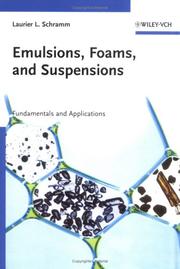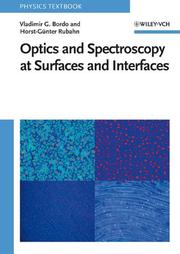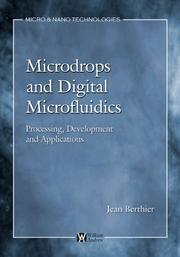| Listing 1 - 6 of 6 |
Sort by
|
Dissertation
ISBN: 9789086497102 Year: 2014 Publisher: Leuven Katholieke Universiteit Leuven
Abstract | Keywords | Export | Availability | Bookmark
 Loading...
Loading...Choose an application
- Reference Manager
- EndNote
- RefWorks (Direct export to RefWorks)
Nonlinear optics is a wide research field based on the nonlinear relationship of the electric field component of light and the induced polarization in matter under intense laser illumination. The second order effect second-harmonic generation (SHG) is often used as a surface characterization tool for materials with a center of symmetry. Due to the advantage of probing surfaces and even buried interfaces, specific material properties can be attributed to the material surface instead of the bulk. Moreover, SHG is very sensitive to changes in the surface structure or alignment of molecules thereon. An additional advantage is the non-invasiveness of SHG, which makes the technique applicable to fragile materials. Exploiting these advantages, SHG can be a useful technique in semiconductor industry, since semiconductor devices consist of a sequence of thin layers. Metal-oxide-semiconductor field-effect transistors (MOSFETs) consist of an oxide layer on top of a semiconductor with different contact areas and are the fundamental parts of e.g. computer chips. The interface between these layers determines the power consumption, reliability, operating voltage, leakage current of the resulting device, etc. Optimizing the interfaces between these layers, will result in an optimized transistor performance. SHG can provide valuable insight in interface-specific processes in semiconductor research.In this work, we investigate the surface and interfaces in MOSFETs. We determine the optimal growth conditions with respect to the carrier gas and temperature during atomic layer deposition (ALD) of the oxide layer. During the ALD process, the composition of the bonds at the surface changes, which results in a change in the isotropic contribution of SHG. For thicker oxide layers, it is shown that the SHG response is thickness independent. Moreover, passivation of the interface is important for optimal device properties. Therefore, the influence of the oxidizing agent and number of oxidation steps on a Si capped Ge layer is probed. Since the operation of MOSFET is voltage dependent, electric field-induced second-harmonic generation (EFISH) is performed on Al2O3 and MgO covered Si substrates. The charges contribute to the EFISH signal, hence a change in charge distribution will result in a changing EFISH intensity. We observe the tunneling of holes from the semiconductor layer to the Al2O3 and migration of oxygen vacancies in MgO. Graphene is an upcoming semiconducting material, which is to be incorporated in a new type of transistor. The capability of using SHG as symmetry-sensitive probe and visualization method is tested on graphene and a novel analyzing method based on fast Fourier-transformation is proposed. These findings illustrate the usefulness of SHG and EFISH to probe buried interfaces in semiconducting material and charge separation therein. In this manner, these second-order nonlinear techniques can push the boundaries in semiconductor manufacturing.
544.722 --- Academic collection --- Chemical surface phenomena, interfacial interactions --- Theses
Dissertation
ISBN: 9789056828912 Year: 2007 Publisher: Leuven Katholieke Universiteit Leuven. Faculteit Toegepaste Wetenschappen
Abstract | Keywords | Export | Availability | Bookmark
 Loading...
Loading...Choose an application
- Reference Manager
- EndNote
- RefWorks (Direct export to RefWorks)
This work has studied the link between the structure of charged colloidal polystyrene particles at a water-air and water-oil interface and its interfacial rheological properties. A first goal was to generate interfacial structures with controlled structural properties and kinetics by tailoring the interaction forces between the particles. It was observed that the classical rules of colloid stability changed when confining particles to an interface. Yet, by changing the composition of the water phase by adding either monovalent salt or combinations of salt and an anionic surfactant SDS excellent control was achieved The following conclusions could be drawn : The addition of NaCl to the water phase leads to a slow aggregation process with DLCA-kinetics and the structure corresponds to a dense RLCA-aggregates with a fractal dimension of 1.58 +/- 0.02. Depending on the ionic strength of the water phase, aggregation is only completed after some weeks. The aggregation is induced by a slow reduction of the strength of the electrostatic interaction. The densification is caused by lateral capillary interactions that depend on the shape and wetting properties of the particles. The addition of small amount of SDS in combination with NaCl reduces the interfacial tension of the water-decane interface and pushes the particles towards the decane phase. The growth kinetics still correspond to the DLCA-regime but aggregation is completed in some days. The structures are more open in agreement to the DLCA-regime. The surface coverage is kept low (f = 0.11) in all experiment to ensure the applicability of the fractal scaling. The effect of SDS on the interaction forces between charged particles could be directly measured using optical tweezers. The pair interaction, the anisotropy in interaction and preliminary measurements of the pair interaction could be measured. The main conclusions are : The pair interaction between particles is found to be repulsive in the initial stages after SDS addition and consistent with a dipole-dipole interaction. The interaction weakens as time proceeds and the rate depends strongly on the concentration of SDS. The interaction is also examined for more complex configurations of three particles. The electrostatic interaction is stronger when a third particle approaches a dimer from the shorter axis compared to an approach from the longer axis. This can explain why the formed aggregates are rather linear during the initial stages of the aggregation process. Experimental proof for the anisotropy of the capillary interaction has been given, at least in the immediate neighborhood of an aggregate. Stick-slip reorganizations are reported on an aggregate made on a (water+1 mM SDS)-decane interface by applying a compressive and extensional force to the aggregate. A magnetic needle interfacial stress rheometer has been built and optimized to measure the rheological properties of Langmuir and Gibbs monolayers. A numerical analysis of the flow field in a channel geometry reveals the intimate coupling between the interface and the bulk fluid. The effect of a low Boussinesq number and a high Reynolds number on the measured moduli has been quantified. It can lead to both an over- and underestimated modulus depending on the exact conditions. The magnitude of the measurement error depends in a non-trivial way on the magnitude as well as the degree of visco-elasticity. The numerical analysis allows to identify the experimental conditions in which the decoupling of bulk and interface has no significant effect on the data. Moreover, an optimization of the technique is possible. A significant reduction of the rod mass combined with a localization of the strongly magnetized part of the rod lowers the dynamic range of the device into a range hardly accessible with other macromechanical interfacial rheometers. The rheological properties of monolayers of colloidal particles have been measured for three different systems. The following results have been found. For a colloidal crystal, a purely elastic behavior is observed when operating well within the measuring limits of the ISR i.e. a low Reynolds and a high Boussinesq number. The elastic modulus strongly increases with increasing surface coverage and a fairly large linear response region is found. Dense aggregated networks at a water-air interface could be induced by adding salt to the water phase. The linear visco-elastic properties scale in a similar manner as their three dimensional counterparts. The elastic modulus shows a power law dependency on the surface coverage while the linearity limit decreases strongly with increasing surface coverage. Aggregation on a water-decane interface could be induced by adding small amounts of SDS and NaCl. The particle networks have an extremely small linearity limit which is at the limit of the measuring technique. At a high surface coverage, a dominantly elastic response is obtained with the modulus being independent of frequency. Surface flocculation is hence observed to be an effective way to create interfaces with solid like rheological properties and most likely allows one to tailor the properties of particle stabilized emulsions, bubbles and foams. Finally, the thermodynamic and rheological properties of a therapeutic replacement lung surfactant, Survanta, are studied. The lack or deficiency of surfactant at the alveolar surface can possibly lead to lethal breathing problems with both premature babies and adults. The characterization of Survanta revealed the following findings: The adsorption kinetics of Survanta at a water-air interface are strongly dependent of temperature and added concentration to the water phase. The process is rather slow except at higher temperature and concentrations. P-A isotherms reveal that the interfacial tension can be reduced close to 0 mN/m by compressing a dilute monolayer. During this compression, the monolayer undergoes a transition between a liquid-expanded and liquid-condensed state at a surface pressure of ~ 45 mN/m. At a higher surface pressure, a second transition, whose exact nature could not be identified, is observed. The dynamic rheological characterization of Survanta reveals that the moduli are strongly dependent on temperature and oscillation frequency. The moduli increase strongly with surface pressure and become more elastic. A strong dependence on the measuring protocol used is also found. Dilatational rheological experiments reveal that the complex modulus is almost independent of frequency and relative area change. Controlling and understanding the behavior of colloidal particles is often determining in an appropriate processing of a large number of filled products. Among these products, both intermediate as well as final products can be found in wide application areas such as coatings, printing inks, paints, filled polymers and food. Colloidal particles have the tenancy to become trapped at a liquid-liquid or a liquid-gas interface and display already pronounced effects even at low concentrations. One of the oldest applications are the so-called Pickering emulsions where colloidal particles are used to stabilize emulsions that are difficult to make using surfactants. The mechanism by which these particles stabilize interfaces differs from the use of surface active components and is for the moment not completely understood. Emerging fields in the use of interfacial particles are found in pharmacy, in applications as colloidosomes for controlled drug delivery and in the stabilization of polymer blends At this moment, lot of these newer applications are still in their development phase and are not used on an industrial scale. The interfacial morphology and its dynamics are possibly crucial parameters in designing these new materials. From a scientific point of view, a number of aspects are already well studied. The physicochemical properties that determine the adsorption and interfacial stability of particles are known. A large variety of structures can be generated which are controlled in a different way compared to particles suspended in bulk fluids. When particles are confined to interfaces additional forces, like capillary and electrocapillary interactions exist, and hence, the electrostatic repulsive force is enhanced. It has recently been shown that no unique relationship between the surface coverage, structure and efficiency in stabilizing interfaces exists . Apart from the static properties, the colloidal dynamics and the interfacial rheology are suggested to be important parameters. Some aspects have already been studied but a systematic approach is still lacking at this moment. In this PhD-work, the structure formation of colloidal particles at interfaces and the corresponding growth kinetics will be studied systematically. Direct measurements of the interaction potential will presented to help understanding the structure development and the resulting mechanical strength of the aggregates. A magnetic needle interfacial stress rheometer will be carefully analyzed and improved allowing to study the possible role of interfacial rheology in the stabilization mechanism of Pickering emulsions. Finally, these concepts will be applied to a technologically important material i.e. a replacement lungsurfactant for therapeutic use.

Abstract | Keywords | Export | Availability | Bookmark
 Loading...
Loading...Choose an application
- Reference Manager
- EndNote
- RefWorks (Direct export to RefWorks)
543.422.27 --- 531.72 --- Electron spectroscopy --- Surfaces (Technology) --- -544.722 --- Characterization of surface --- Surface analysis --- Surface characterization --- Chemistry, Analytic --- Surface chemistry --- Electron spectroscopy for chemical analysis --- ESCA --- Electrons --- X-rays --- 531.72 Measurement of surfaces, sections --- Measurement of surfaces, sections --- 543.422.27 Using ultra-high frequency electromagnetic waves (microwaves). Electron spin resonance spectroscopy --- Using ultra-high frequency electromagnetic waves (microwaves). Electron spin resonance spectroscopy --- Analysis --- Chemical surface phenomena, interfacial interactions --- Emission --- Surfaces (Technologie) --- Spectroscopie électronique --- Spectroscopie électronique --- Electron spectroscopy. --- Analysis. --- 544.722 --- Spectrometric and optical chemical analysis --- fysicochemie --- Materials sciences --- Analyse --- Analytical chemistry --- Electronics. --- Metallurgy. --- Catalysis --- Corrosion --- Electron emission --- Instrumentation --- Photoelectron spectra --- Polymers

ISBN: 9783527307432 3527307435 Year: 2005 Publisher: Weinheim Wiley
Abstract | Keywords | Export | Availability | Bookmark
 Loading...
Loading...Choose an application
- Reference Manager
- EndNote
- RefWorks (Direct export to RefWorks)
Emulsions --- Foams --- Suspensions (Chemistry) --- 661.18 --- 541.18 --- 544.722 --- Colloids. Surface-active agents. Washing, foaming, flotation agents etc. --- Colloid chemistry. Chemistry of adsorption phenomena. Capillary chemistry --- Chemical surface phenomena, interfacial interactions --- 541.18 Colloid chemistry. Chemistry of adsorption phenomena. Capillary chemistry --- 661.18 Colloids. Surface-active agents. Washing, foaming, flotation agents etc.

ISBN: 9783527405602 3527405607 Year: 2005 Publisher: Weinheim Wiley-VCH
Abstract | Keywords | Export | Availability | Bookmark
 Loading...
Loading...Choose an application
- Reference Manager
- EndNote
- RefWorks (Direct export to RefWorks)
Surfaces (Physics) --- Surface chemistry --- Interfaces (Physical sciences) --- Surfaces (Physique) --- Chimie des surfaces --- Interfaces (Sciences physiques) --- Optical properties --- Propriétés optiques --- Spektroskopie --- 544.722 --- Chemical surface phenomena, interfacial interactions --- Propriétés optiques --- Physics --- Surfaces (Technology) --- Chemistry, Surface --- Interfaces, Chemistry of --- Surface phenomena --- Surfaces (Chemistry) --- Chemistry, Physical and theoretical --- Capillarity --- Surface energy --- Surface tension --- Surfaces (Physics) - Optical properties - Textbooks. --- Surface chemistry - Textbooks. --- Interfaces (Physical sciences) - Textbooks. --- Acqui 2006

ISBN: 0815515448 9780815515449 1282169807 0815518358 0080947395 9781601195791 1601195796 9780815518341 081551834X 9780080947396 1282011251 9781282011250 9780815518358 9781282169807 Year: 2008 Publisher: Norwich, NY William Andrew Pub.
Abstract | Keywords | Export | Availability | Bookmark
 Loading...
Loading...Choose an application
- Reference Manager
- EndNote
- RefWorks (Direct export to RefWorks)
After spending over 12 years developing new microsystems for biotechnology û especially concerned with the microfluidic aspects of these devices û Jean Berthier is considered a leading authority in the field. Now, following the success of his book, Microfluidics for Biotechnology, Dr. Berthier returns to explain how new miniaturization techniques have dramatically expanded the area of microfluidic applications and microsystems into microdrops and digital microfluidics.Engineers interested in designing more versatile microsystems and students who seek to learn the fundamentals of micro
Atomizers --- Drops --- Electrostatic atomization --- Microdroplets --- Microelectromechanical systems --- Microfluidics --- Spraying equipment --- 532.64 --- 544.722.3 --- 57.088 --- 631.347.3 --- 66.063.5 --- 66.069.832 --- Spraying --- Agricultural implements --- Agricultural machinery --- Gardening --- Fluidics --- Nanofluids --- MEMS (Microelectromechanical systems) --- Micro-electro-mechanical systems --- Micro-machinery --- Microelectromechanical devices --- Micromachinery --- Micromachines --- Micromechanical devices --- Micromechanical systems --- Electromechanical devices --- Microtechnology --- Mechatronics --- Atomization --- Drips --- Droplets --- Liquids --- Spheroidal state --- Nebulizers --- Perfumizers --- 57.088 Special methods and techniques for studing biological molecules. Separation. Centrifuging. X-ray study. Radioisotope methods --- Special methods and techniques for studing biological molecules. Separation. Centrifuging. X-ray study. Radioisotope methods --- 532.64 Wetting angle. Contact angle --- Wetting angle. Contact angle --- 66.063.5 Wetting. Moistening. Wetting agents --- Wetting. Moistening. Wetting agents --- 631.347.3 Spraying equipment. Sprinklers. Sprays, spray-guns, jets --- Spraying equipment. Sprinklers. Sprays, spray-guns, jets --- Methodology --- Equipment and supplies --- Wettability. Chemical nature of wetting. Spreading. Spreading ability --- Atomizing. Spraying. Atomizers and spraying devices --- Equipment --- Engineering --- Mechanical Engineering --- Atomizers. --- Microelectromechanical systems. --- Equipment and supplies. --- Methodology. --- Coating processes
| Listing 1 - 6 of 6 |
Sort by
|

 Search
Search Feedback
Feedback About
About Help
Help News
News